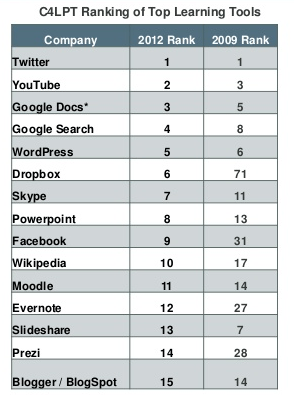If you haven’t scrolled through all 117 slides of Mary Meeker’s D11 presentation, you’re doing yourself an disservice (you can check it out here and put it in your Pocket for later.) The slides are full of fascinating data points about the state of the Web and technology today, and beyond being great fodder for small talk, there are dozens of insights that we can latch onto as brand marketers.
One particularly fascinating point was the below juxtaposition of popular learning tools circa 2012 and 2009. Needless to say, the way we learn has changed a great deal in three years. The study itself (commissioned by the Center for Learning & Performance Technology) asked 582 learning professionals worldwide to provide their top ten tools used for learning in 2012 and back in 2009. For the purpose of the survey, learning tool was defined as “any tool that you can use to create or deliver learning content/solutions for others, or a tool you use for your own personal learning.”
 In 2012, the top five learning tools were identified as Twitter, YouTube, Google Docs, Google search and WordPress. What do learning tools have to do with brand marketers? They are the ideal platforms for us to share what we know with potential customers.
In 2012, the top five learning tools were identified as Twitter, YouTube, Google Docs, Google search and WordPress. What do learning tools have to do with brand marketers? They are the ideal platforms for us to share what we know with potential customers.
How can your brand build thought leadership on these platforms? It’s a two-parter. In no particular order, you’ve got to reach the right people, and you’ve got to provide remarkable content. Let’s go through each of the top platforms to demonstrate how each of the most popular learning tools can be optimized for content marketing.
Reach the right audience:
- Optimize your bio to be discoverable via Twitter Search.
- Thoughtfully interact with others in the form of replies, retweets and favorites. The more your handle shows up in meaningful conversations in others’ feeds, the more people will recognize, follow and ultimately consume your content.
- Use a tool like Tweriod to discover the most engaging times to tweet from your account.
Provide remarkable content:
- Share your brand’s original content in interesting ways. Generic have become a bit passé, so try to mix up the messaging you include with your link.
- But only sharing your own content can grow tiresome, so mix it up with a bit of curation from smart people in your industry. Tools like Content DJ and Buffer can simplify the process.
YouTube
Reach the right audience:
- Try promoting your videos via email marketing. It’s easy enough to send out a link to your list, and it can get a lot of new eyeballs on your content. Here are a few tips for promoting video content with email.
- To pull more people into your YouTube audience, add a “subscribe” call to action in your videos either verbally or using YouTube’s annotations.
- Optimize your videos for search by using the right keywords in your title, description and tags. More on that here.
Provide remarkable content:
- Focus on how-tos that haven’t been done before. Louis Vuitton pulled this off with an excellent series of videos that show off their products while demonstrating a more efficient way to pack.
- Get creative with shots, especially if your production budget is limited.
Google Docs
Reach the right audience:
- If you have Google Apps, you can adjust share settings to make a document (text, spreadsheet, presentation, etc.) public or available to anyone with a link. While Google Docs might not be the best standalone content, they can be a good fit inside a blog post as further reference or a tool to help your audience execute the lesson you provided.
Provide remarkable content:
- Share reusable templates that your audience will benefit from, like a worksheet with all the necessary elements for a blog post, or the social media editorial calendar spreadsheet you’ve perfected over time.
- Share slide decks from conferences and internal learning sessions (although SlideShare is probably a better platform for this).
Google Search
Reach the right audience:
- It doesn’t matter which medium you’re using for content marketing — if it’s on the web, you’ll want it to be discoverable via Google search as a way to reach people that aren’t already familiar with you and your content.
Provide remarkable content:
- Search is an overarching principle for content, so keep your content’s search-ability in mind when creating and sharing on all platforms. This includes meta data, social bios and keywords.
- Build links to your content by sharing your expertise with other bloggers. Help A Reporter Out is a great tool for this. To get started, read our tips for getting press as a HARO source.
WordPress
Reach the right audience:
- Best practices are constantly changing when it comes to SEO for bloggers, but there is one thing that remains consistent: quality. Well-written blog posts that actually help people solve real problems will always perform better via search, social and old fashioned PR.
Provide remarkable content:
- One of the hardest parts of blogging is coming up with a consistent stream of “remarkable content” topics. Support your brainstorming efforts with external tools like data, Reddit’s Ask Me Anything sessions and Quora. And to support your already-established ideas, get quotes and data using the reporter’s side of HARO.
